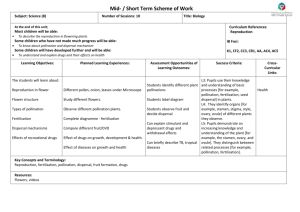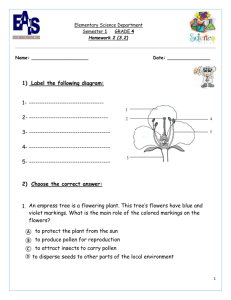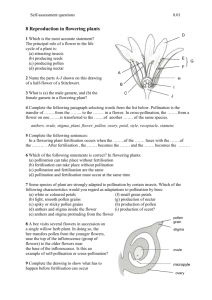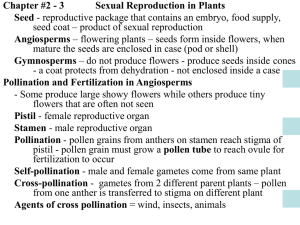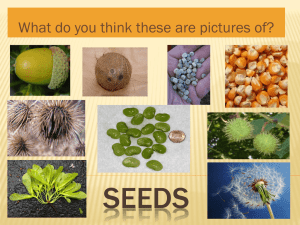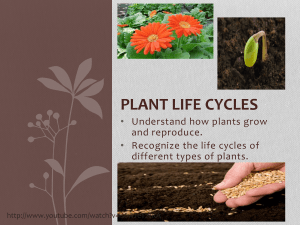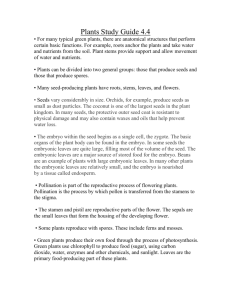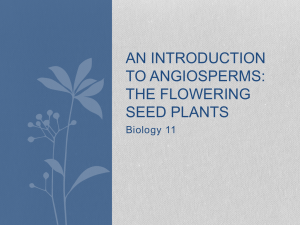Activity 9 Plant Life Cycle and flower structure
advertisement
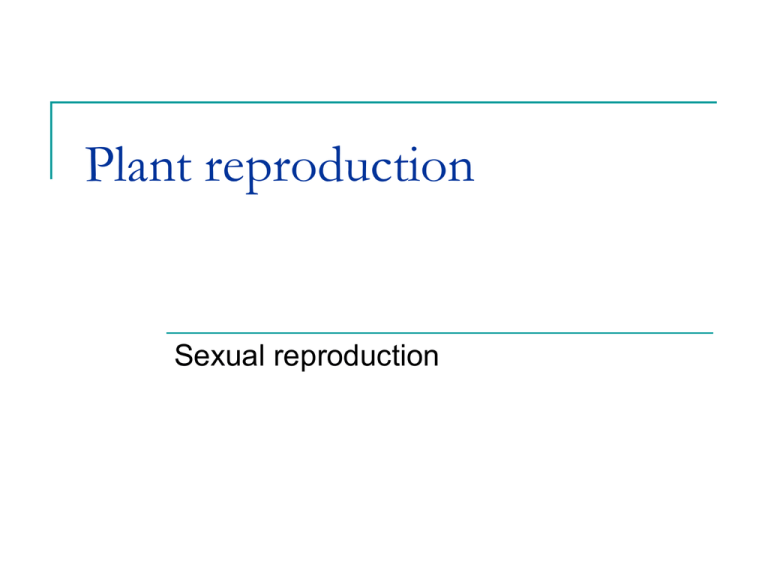
Plant reproduction Sexual reproduction Learning Intentions I can describe methods of sexual reproduction in plants I can describe the process of pollination, fertilisation , seed formation and dispersal Success Criteria Success Criteria I can state plants use flowers as a method of sexual reproduction I can put the stages of a plants life cycle in order I can define pollination and fertilisation I can describe how pollination and fertilisation occurs in plants I can explain how seeds are formed I can describe methods of seed dispersal I can explain the advantages of seed dispersal I am able to label diagrams correctly Plant Life Cycle A plants life cycle shows all the stages in a flowers life Tomato plant From seed to flower And back to seeds This is plant reproduction It allows plants to reproduce so new flowers will form again and again This flower has been pollinated. Now the fruit, containing seeds, is developing. Flower Tomato plant life cycle Germination Fruit and seed development and dispersal Pollination and fertilisation Plant growth Flower formation Parts of a flower Petals – bright to attract insects Stamen contains the anther which splits down the middle to release the pollen Stigma The stigma is the region to which pollen grains become attached Nectary – makes sugary nectar which insects eat Sepals - protects unopened flower Ovary – female part of the flower that contains the ovules Arrangement of ovules as seen in cross section of ovary Pollination •The pistil is part of the stigma. •Pollination is the transfer of pollen from the anther to the stigma Insect pollination e.g. Passion flower Wind Pollination e.g. Sedge Methods of Pollination Insect pollination Wind pollination Have a scent No scent Sticky, spiky pollen Sticky stigma inside flower Stamens surrounded by petals Produce nectar Large amounts of light pollen Feathery stigmas hang outside the flower Large stamens hang outside flower Don’t produce nectar Petals large & bright Petals small & dull Fertilisation Once the pollen grain lands on the stigma, it grows a pollen tube down to the ovule. Fertilisation is when the nucleus of the pollen grain fuses with the nucleus of the ovule The fertilised ovule develops into a seed The ovary wall develops into the fruit. Seed dispersal Following pollination and fertilisation seed formation and dispersal takes place Seed Dispersal – this is where seeds are scattered away from the parent Seeds are scattered to avoid competition for water, light and nutrients Animal (external) Seeds can be dispersed by animals. The seed has hooks which catch onto animals’ fur and are transported by the animal until they fall off and hopefully germinate elsewhere. E.g. Burdock Animal (internal) Seeds can also be eaten by animals along with the fruit. The seeds pass through the animal and are deposited in the droppings elsewhere E.g. bramble Wind Dispersal Plants can also use the wind to scatter their seeds and they use different mechanisms to achieve this. E.g. the poppy uses the “pepper pot” method Wind Dispersal Ragwort, dandelions, cotton, etc. use the “parachute” method. Each seed has a number of small feather-like structures to help it float in the wind. Wind Dispersal Some seeds have wings to help them fly in the wind. E.g. sycamore, ash, etc.. Explosive Some plants such as peas and gorse use pods which “explode” to fire the seeds away from the parent. As a pod dries, tensions are set up in the wall of the pod eventually causing it to split along two lines of weakness. Advantages of seed dispersal It reduces competition for resources eg. light, water and mineral nutrients It reduces the spread of disease It allow plants to grow in a wider area so more likely to survive in event of a flood or fire. Seed germination With water, oxygen and the right temperature the seed swells and begins to make a new plant Germination occurs Stems grow up towards the light, leaves unfold to take more sunlight and roots anchor the plant Growth

